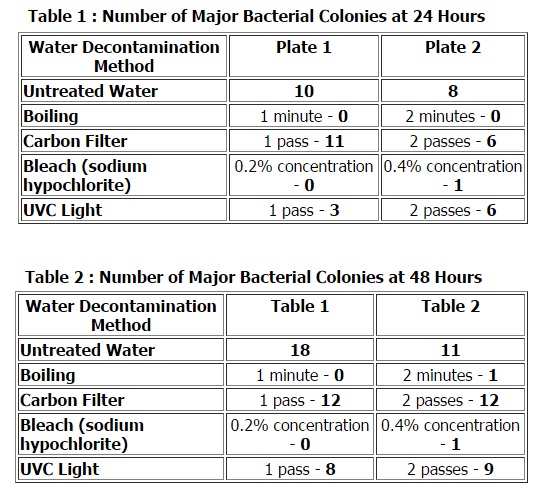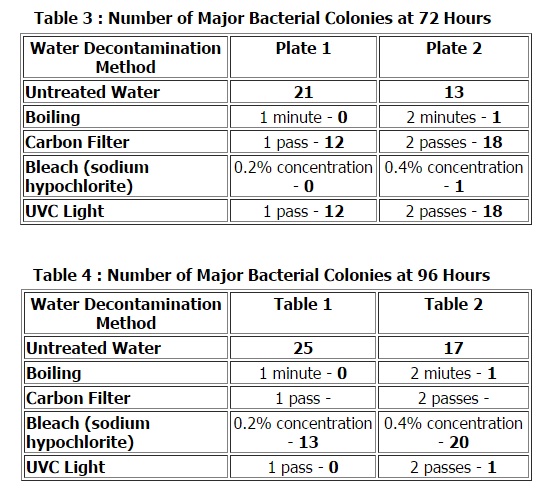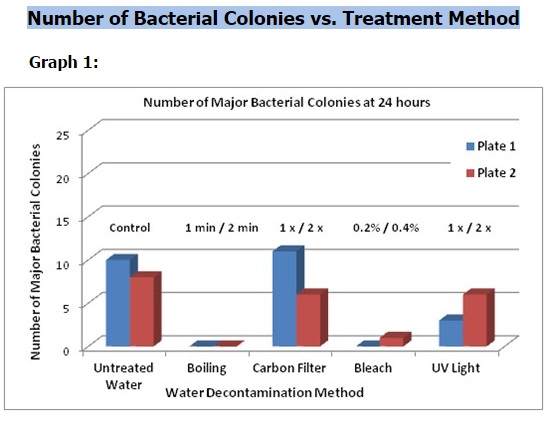





Published on Feb 13, 2025
The objective: The project tested the effectiveness of four different methods of water decontamination: boiling, carbon filter, chlorine, and UVC light filter. I performed the water decontamination methods on lake water that was contaminated with E. coli bacteria. I took a sample of the water after performing each decontamination procedure by swabbing the water samples onto tryptic soy agar plates. I measured and recorded any bacterial growth at 24, 48, 72, and 96 hour increments.
Which is the most effective water decontamination method: boiling, carbon filter, chlorine, or UVC light filter? I performed these water decontamination methods on lake water that was contaminated with E. coli bacteria. I then took samples of the water after performing each decontamination procedure, swabbing the water samples onto tryptic soy agar plates, and then placing the plates in a container heated to 37° C. I measured and recorded any bacterial colony growth at 24, 48, 72, and 96 hour increments.
I tested boiling at one, two, and three minutes; the carbon filter with one, two and three passes through the filter; the chlorine at 0.2%, 0.4%, and 0.6% concentrations; and the UVC light filter with one, two and three passes through the filter. I concluded that water decontamination by boiling and treating with chlorine were by far the most effective, followed by the UVC light filter and finally the carbon filter.
The problem I would like to address is that many people do not have access to clean water for drinking and cleaning. Also, when people go on camping trips or travel to remote places, they need to be able to easily purify their water. My experiment tests what the best, most convenient water decontamination method is: boiling, carbon filters, UV light, or chemicals. It will also test whether or not these decontamination methods will clarify the water.
Question
If I change the water decontamination method, then what will happen to the bacteria in the water?
One method of water decontamination is boiling. Most bacteria will die quickly at high temperatures (over 100 degrees Celsius). The water should be safe to drink after 1-3 minutes of boiling. Another way to clean water is to use carbon filters (also known as activated charcoal). The outcome of the carbon in these filters being treated with oxygen is many tiny holes between the carbon atoms. This manufacturing technique results in a 300-2000m² surface area per gram of carbon. Due to these tiny holes, liquids pass through these holes, and absorb a wide range of impurities and contaminants.
Also, ultraviolet light (UV light) will damage the DNA of microbes and pathogens so that they cannot reproduce and cause illness, therefore cleaning the water. To ensure that the water is clean, chemicals may be used. Chlorine and can be added to the water to kill bacteria by attacking the lipids in the cell walls and destroying the enzymes and structures inside the cell, making it harmless.
To clean the water by boiling, just boil the water for 1-3 minutes. If using a carbon filter, just pour the water through the filter. For decontamination by UV light, put water in a clear bottle. If the water is not clear, use a filter to strain out any particulates. Let sit in the UV light for 30-80 seconds. When using a chemical, put the chemical (iodine or chlorine) in the water bottle and let sit for several hours (the time required may vary with the chemical).
Tryptic soy agar plates contain a growth medium that provides nutrients for bacteria to grow. If there are bacteria in the substance being tested, you will be able to see the bacteria grow on the plates. There are no safety concerns related to tryptic soy agar plates.
These methods for decontaminating water could be used on camping trips or for hiking in the wilderness. Another application is houses and cottages without access to a clean water supply, such as water drawn from wells or lakes. Also, countries where there are regions without access to uncontaminated water could use these methods. Continuing to decontaminate already treated water, if it is not sufficiently clean, is another practical use for these methods.
All of these methods can easily be performed; they are quick, easy, inexpensive, and require very little equipment. Boiling is one of the most effective, fastest, and easiest ways to decontaminate water. Carbon filters will absorb pathogens, as well as colours and other impurities. UV light is a great method because there are no health concerns, waiting times, or unpleasant tastes that may be associated with other methods. Chemicals such as chlorine and iodine are convenient and easy to transport.
However, these methods all have drawbacks as well. Boiling needs a heat source, so it may require the burning of wood or other fuels that may emit pollutants, or the use of electricity which may not always be available. Boiling does not filter out dirt, and the water does not always taste good or quench thirst well after boiling. The downside to carbon filters is that eventually, the filters need to be replaced because the charcoal will be filled with bacteria, chemicals, and impurities. UV light will only work on clear water; it will not work on turbid water, so the water may have to be filtered after UV treatment. Also, UV treatment does not filter out dirt, metals, or chemicals, and a small light only can purify small batches of water. Chemicals do not filter out dirt, metals, or particulates; the taste might be unpleasant; and there may be health concerns if the level of chemicals in the water is too high, or if the chemicals are used over a long time period.
The water: should not contain any bacteria, protozoa, or viruses; should not be turbid because turbidity could negatively affect the decontamination process; and should be free of chemicals, toxins, and pesticides.
Boiling will take a few minutes; carbon filters will take several of seconds; UV light will take 30-80 seconds under the light; and chemicals may take up to several hours, depending on the chemical being used.
Boiling requires a heat source; carbon filters use a carbon filter; UV light needs a UV light; and chemicals are either iodine or chlorine.
I predict that all the methods of water decontamination I am using will kill bacteria in the water. I think that boiling will work best, then the bleach, after that UV light, and finally carbon filters.
I think this will happen because the heat from boiling the water will kill all bacteria. Carbon filters use carbon that has been treated with oxygen to form many tiny holes between the carbon atoms, which absorb a wide range of impurities. Ultraviolet light will damage the DNA of bacteria so that they cannot reproduce and cause illness, therefore cleaning the water. Chlorine will attack the lipids in the cell walls and destroy enzymes and structures inside the cell, making the bacteria harmless. Also, only the carbon filters will clarify any suspended solids in the wate



In conclusion, when I changed the method of water decontamination, I discovered that, based on the amount of bacteria that grew in each tryptic soy agar plate, boiling worked best, then the chlorine bleach, after that the UV light filter, and finally the carbon filter.
The method of boiling almost completely decontaminated the water; the plate where the water was boiled for one minute did not have any bacterial growth, and the plate that was boiled for two minutes only had one bacterial growth after 48 hours. The results for the bleach were very similar to boiling, as there was no bacterial growth in the 0.2% concentration, but there was one bacterial colony in the 0.4% concentration.
The only differences were that the bacteria started to grow at 24 hours, and it was much larger. The tryptic soy agar plate that had the water from the UV light filter from 1 pass had 3, 8, 12, and 12 major bacterial colonies at 24, 48, 72, and 96 hours respectively. There were 6, 9, 11, and 11 major bacterial colonies on the plate from 2 passes through the UV light filter at 24, 48, 72, and 96 hours respectively. The carbon filter, which was the least effective method tested, had 11 bacterial colonies at 24 hours, 12 bacterial colonies at 48 and 72 hours, and 13 bacterial colonies at 96 hours when the water had one pass through the filter. At two passes, there were 6, 12, 18, and 20 bacterial cultures at 24, 48, 72, and 96 hours respectively.
It is quite evident that there is a big difference between the cleanliness of the water when boiling or using bleach, and using a UV light filter or a carbon filter. Although some of the methods tested were not very effective, the untreated water (the control) grew more bacteria than any of the other methods tested. The first sample had 10, 18, 21, and 25 major bacterial growths at 24, 48, 72, and 96 hours; the second sample had 8, 11, 13, and 17 major bacterial growths at 24, 48, 72, and 96 hours. Also, the control had a brownish colour. The control, UV filter, and carbon filter all had many smaller bacterial colonies, which were too small to count.
The bacterial colonies growing on the plates all grew larger as the time progressed. There were no easily measurable results for the third set of plates, which included: untreated water, testing boiled water for 3 minutes, 0.6% concentration of bleach, 3 passes through the UV light filter, and 3 passes through the carbon filter. There was a lot of water on the plates due to condensation collecting on the underside of each of the lids on the plates and dripping onto the tryptic soy agar, which allowed the bacterial culture to spread across the surface. However, the data from the two sets of plates is conclusive, and supports my predictions, so I accept my hypothesis.
Boiling is an effective method because heat will kill the bacteria within a matter of minutes once the water is boiling. Bleach is also an effective method of water decontamination, as its active ingredient is sodium hypochlorite. The hypochlorite ion oxidizes the outer cell membrane of the bacteria, which destroys the membrane and kills the bacteria. The UV light filter, which used a UV C light, does not actually kill bacteria; it alters the cell DNA of bacteria to sterilize them. This stops them from proliferating and causing disease. The carbon filter will filter out harmful contaminants such as copper, mercury, and cadmium, zinc and chlorine, improving the taste, and removing particles; however, it does not kill bacteria.
These results could benefit a significant portion of the world's population. There are many people who live in remote places who do not have access to clean drinking water; for example, people who live in small towns or at cottages or chalets without adequate water decontamination systems. Also, people who are going camping who cannot bring clean water with them could effectively treat their water using small, portable systems. Municipal water treatment could also use my results to ensure the cleanest water possible. Finally, there are millions of people living in developed countries without access to any clean water, and these methods are easy to implement and could benefit them greatly, by enabling them to have uncontaminated water.
After performing this experiment, I have more questions about the topic of methods of water decontamination. The UV light filter did not work very well to decontaminate the water. Would a more powerful UVC light work better? How many times does the water need to pass through the UV filter in order for it to work? Would a different design of the UV light be more effective, so that more water passes closer to the light source? Also, the bleach worked quite well to eliminate bacteria, but too much chlorine in water can be harmful to health. So, one question would be, what is the minimum concentration of bleach needed to properly decontaminate the water? Another question I have is: since all the methods helped decontaminate the water, would performing a combination of methods on contaminated water, perhaps at lower concentrations or durations and therefore perhaps at a lower total cost), completely decontaminate the water? Are some treatment combinations more effective than others?
A future experiment I could perform is testing various combinations of water decontamination methods. For example, I compare UV light filter and bleach to carbon filter and boiling or bleach and boiling to carbon filter and UV light filter. Also, I could test all of the methods of water decontamination together. These results would be helpful because it is essential to find a combination that will completely decontaminate drinking water every time. Some methods will not kill all types of bacteria, so depending on the sources of contamination, it may be important to use more than one method when decontaminating water to make sure that it is safe to use and drink.
Curtis, Rick. (1998). The Backpacker's Field Manual. Random House: N/A. OA Guide to Water Purification.
Helmenstine, Anne Marie. (N/A). What is Activated Charcoal and How does it Work?. N/A: N/A. November 13, 2013.
N/A. (2013). Back Country Water Treatment. Mountain Equipment Co-op: N/A. November 13, 2013.
N/A. (2013). Water: Purification Methods. National Geographic: N/A. November 13, 2013.
N/A. (2013). Water Disinfection. Centers for Disease Control and Prevention: N/A. November 13, 2013.
N/A. (N/A). Escherichia coli. redOrbit: N/A. December 29, 2013.
N/A. (N/A). Tryptic Soy Agar (TSA). Hardy diagnostics: Santa Maria, California, USA. December 29, 2013.